ECO mode JEEP WRANGLER UNLIMITED 2020 Owner handbook (in English)
[x] Cancel search | Manufacturer: JEEP, Model Year: 2020, Model line: WRANGLER UNLIMITED, Model: JEEP WRANGLER UNLIMITED 2020Pages: 330, PDF Size: 9.16 MB
Page 48 of 330
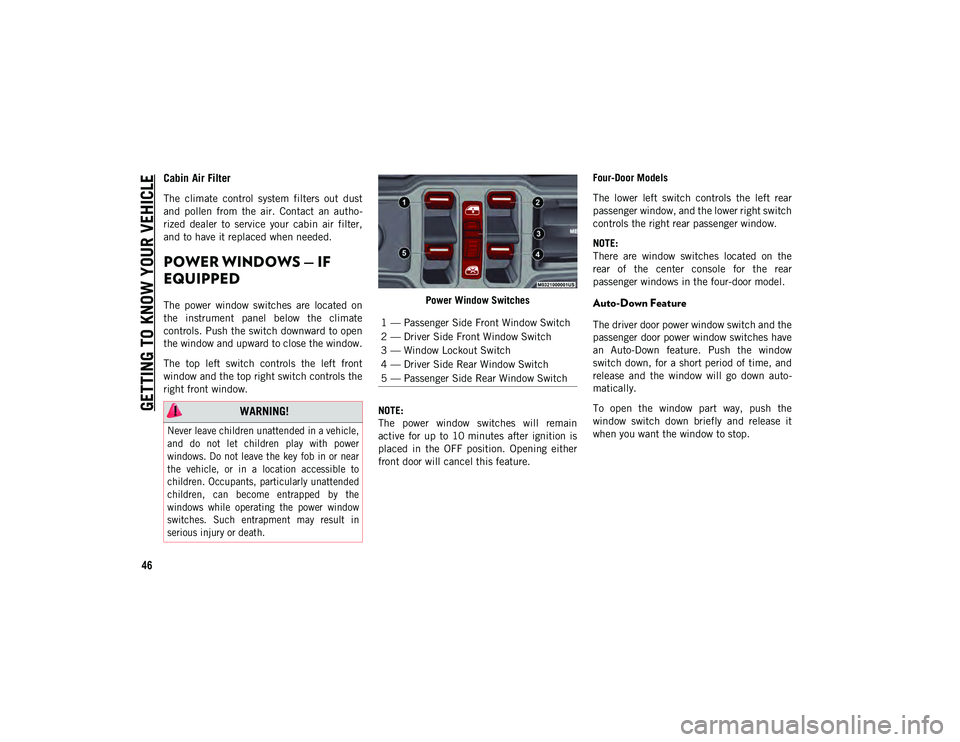
GETTING TO KNOW YOUR VEHICLE
46
Cabin Air Filter
The climate control system filters out dust
and pollen from the air. Contact an autho-
rized dealer to service your cabin air filter,
and to have it replaced when needed.
POWER WINDOWS ŌĆö IF
EQUIPPED
The power window switches are located on
the instrument panel below the climate
controls. Push the switch downward to open
the window and upward to close the window.
The top left switch controls the left front
window and the top right switch controls the
right front window. Power Window Switches
NOTE:
The power window switches will remain
active for up to 10 minutes after ignition is
placed in the OFF position. Opening either
front door will cancel this feature. Four-Door Models
The lower left switch controls the left rear
passenger window, and the lower right switch
controls the right rear passenger window.
NOTE:
There are window switches located on the
rear of the center console for the rear
passenger windows in the four-door model.Auto-Down Feature
The driver door power window switch and the
passenger door power window switches have
an Auto-Down feature. Push the window
switch down, for a short period of time, and
release and the window will go down auto
-
matically.
To open the window part way, push the
window switch down briefly and release it
when you want the window to stop.
WARNING!
Never leave children unattended in a vehicle,
and do not let children play with power
windows. Do not leave the key fob in or near
the vehicle, or in a location accessible to
children. Occupants, particularly unattended
children, can become entrapped by the
windows while operating the power window
switches. Such entrapment may result in
serious injury or death.
1 ŌĆö Passenger Side Front Window Switch
2 ŌĆö Driver Side Front Window Switch
3 ŌĆö Window Lockout Switch
4 ŌĆö Driver Side Rear Window Switch
5 ŌĆö Passenger Side Rear Window Switch
2020_JEEP_JL_WRANGLER_UG_RHD_UK.book Page 46
Page 56 of 330
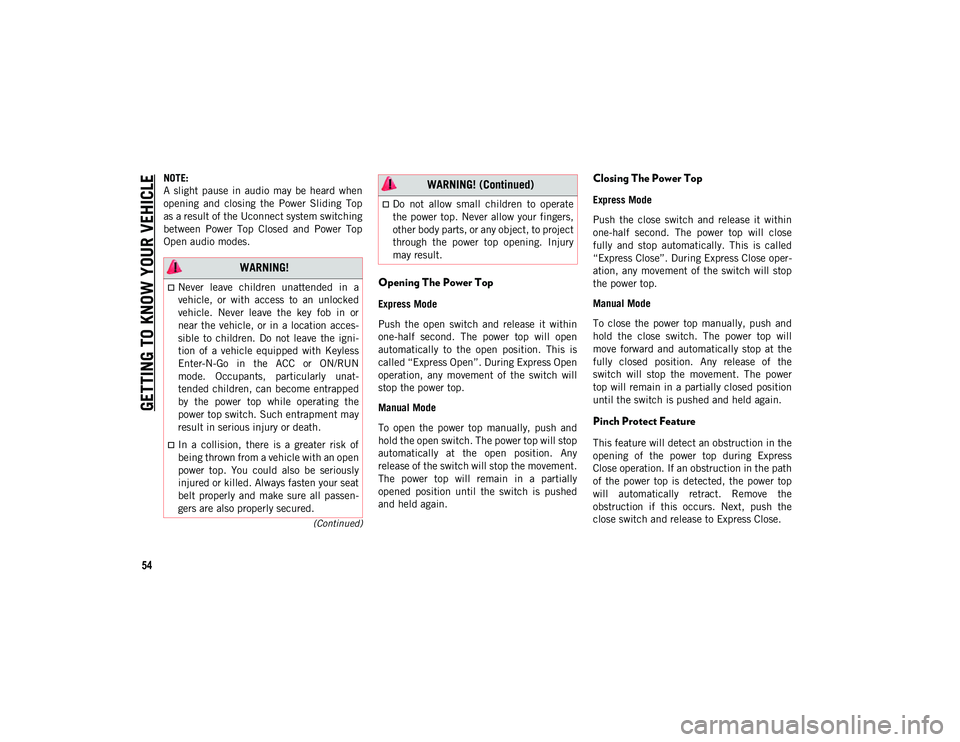
GETTING TO KNOW YOUR VEHICLE
54
(Continued)
NOTE:
A slight pause in audio may be heard when
opening and closing the Power Sliding Top
as a result of the Uconnect system switching
between Power Top Closed and Power Top
Open audio modes.
Opening The Power Top
Express Mode
Push the open switch and release it within
one-half second. The power top will open
automatically to the open position. This is
called ŌĆ£Express OpenŌĆØ. During Express Open
operation, any movement of the switch will
stop the power top.
Manual Mode
To open the power top manually, push and
hold the open switch. The power top will stop
automatically at the open position. Any
release of the switch will stop the movement.
The power top will remain in a partially
opened position until the switch is pushed
and held again.
Closing The Power Top
Express Mode
Push the close switch and release it within
one-half second. The power top will close
fully and stop automatically. This is called
ŌĆ£Express CloseŌĆØ. During Express Close oper-
ation, any movement of the switch will stop
the power top.
Manual Mode
To close the power top manually, push and
hold the close switch. The power top will
move forward and automatically stop at the
fully closed position. Any release of the
switch will stop the movement. The power
top will remain in a partially closed position
until the switch is pushed and held again.
Pinch Protect Feature
This feature will detect an obstruction in the
opening of the power top during Express
Close operation. If an obstruction in the path
of the power top is detected, the power top
will automatically retract. Remove the
obstruction if this occurs. Next, push the
close switch and release to Express Close.
WARNING!
’ü»Never leave children unattended in a
vehicle, or with access to an unlocked
vehicle. Never leave the key fob in or
near the vehicle, or in a location acces-
sible to children. Do not leave the igni -
tion of a vehicle equipped with Keyless
Enter-N-Go in the ACC or ON/RUN
mode. Occupants, particularly unat -
tended children, can become entrapped
by the power top while operating the
power top switch. Such entrapment may
result in serious injury or death.
’ü»In a collision, there is a greater risk of
being thrown from a vehicle with an open
power top. You could also be seriously
injured or killed. Always fasten your seat
belt properly and make sure all passen -
gers are also properly secured.
’ü»Do not allow small children to operate
the power top. Never allow your fingers,
other body parts, or any object, to project
through the power top opening. Injury
may result.
WARNING! (Continued)
2020_JEEP_JL_WRANGLER_UG_RHD_UK.book Page 54
Page 58 of 330
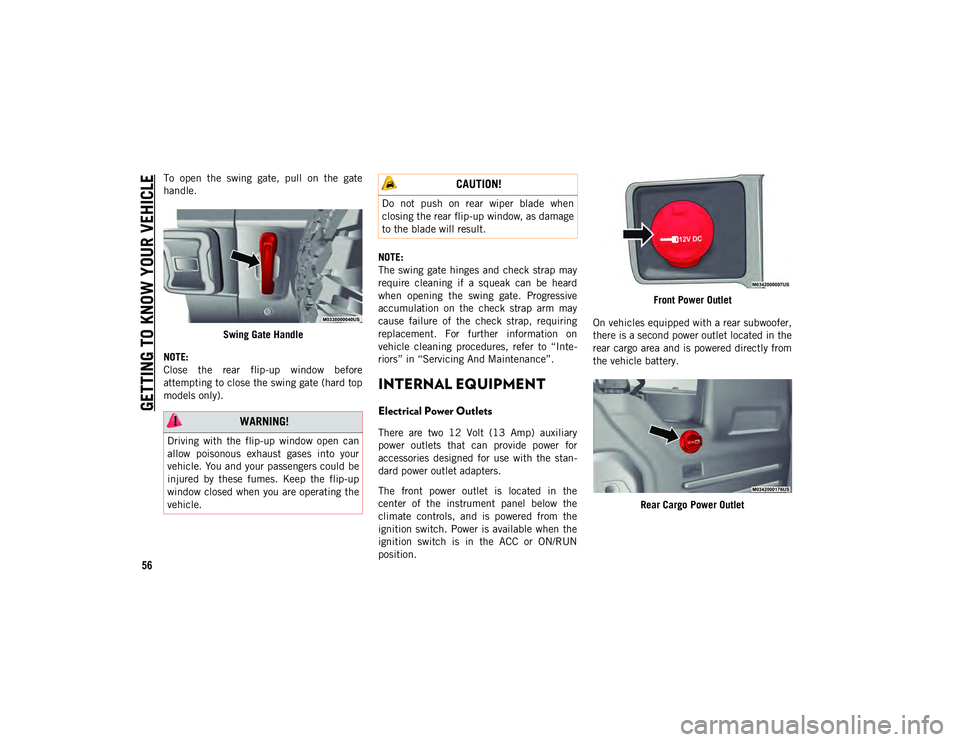
GETTING TO KNOW YOUR VEHICLE
56
To open the swing gate, pull on the gate
handle.Swing Gate Handle
NOTE:
Close the rear flip-up window before
attempting to close the swing gate (hard top
models only). NOTE:
The swing gate hinges and check strap may
require cleaning if a squeak can be heard
when opening the swing gate. Progressive
accumulation on the check strap arm may
cause failure of the check strap, requiring
replacement. For further information on
vehicle cleaning procedures, refer to ŌĆ£Inte
-
riorsŌĆØ in ŌĆ£Servicing And MaintenanceŌĆØ.
INTERNAL EQUIPMENT
Electrical Power Outlets
There are two 12 Volt (13 Amp) auxiliary
power outlets that can provide power for
accessories designed for use with the stan -
dard power outlet adapters.
The front power outlet is located in the
center of the instrument panel below the
climate controls, and is powered from the
ignition switch. Power is available when the
ignition switch is in the ACC or ON/RUN
position. Front Power Outlet
On vehicles equipped with a rear subwoofer,
there is a second power outlet located in the
rear cargo area and is powered directly from
the vehicle battery.
Rear Cargo Power Outlet WARNING!
Driving with the flip-up window open can
allow poisonous exhaust gases into your
vehicle. You and your passengers could be
injured by these fumes. Keep the flip-up
window closed when you are operating the
vehicle.
CAUTION!
Do not push on rear wiper blade when
closing the rear flip-up window, as damage
to the blade will result.
2020_JEEP_JL_WRANGLER_UG_RHD_UK.book Page 56
Page 62 of 330
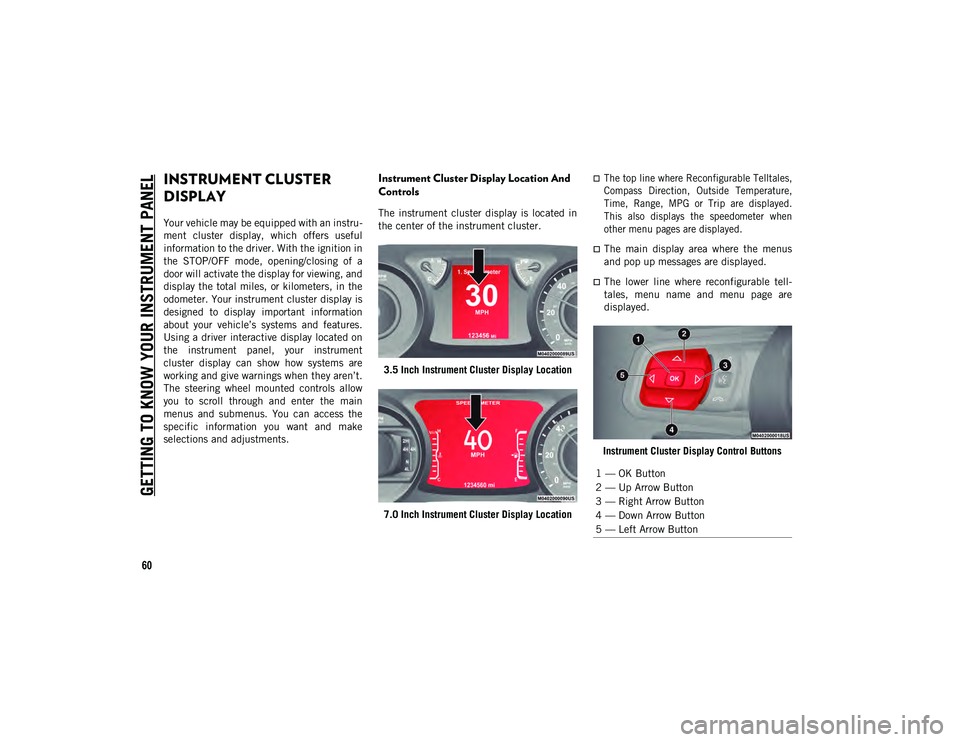
60
GETTING TO KNOW YOUR INSTRUMENT PANEL
INSTRUMENT CLUSTER
DISPLAY
Your vehicle may be equipped with an instru-
ment cluster display, which offers useful
information to the driver. With the ignition in
the STOP/OFF mode, opening/closing of a
door will activate the display for viewing, and
display the total miles, or kilometers, in the
odometer. Your instrument cluster display is
designed to display important information
about your vehicleŌĆÖs systems and features.
Using a driver interactive display located on
the instrument panel, your instrument
cluster display can show how systems are
working and give warnings when they arenŌĆÖt.
The steering wheel mounted controls allow
you to scroll through and enter the main
menus and submenus. You can access the
specific information you want and make
selections and adjustments.
Instrument Cluster Display Location And
Controls
The instrument cluster display is located in
the center of the instrument cluster.
3.5 Inch Instrument Cluster Display Location
7.0 Inch Instrument Cluster Display Location
’ü»The top line where Reconfigurable Telltales,
Compass Direction, Outside Temperature,
Time, Range, MPG or Trip are displayed.
This also displays the speedometer when
other menu pages are displayed.
’ü»The main display area where the menus
and pop up messages are displayed.
’ü»The lower line where reconfigurable tell -
tales, menu name and menu page are
displayed.
Instrument Cluster Display Control Buttons
1 ŌĆö OK Button
2 ŌĆö Up Arrow Button
3 ŌĆö Right Arrow Button
4 ŌĆö Down Arrow Button
5 ŌĆö Left Arrow Button
2020_JEEP_JL_WRANGLER_UG_RHD_UK.book Page 60
Page 64 of 330
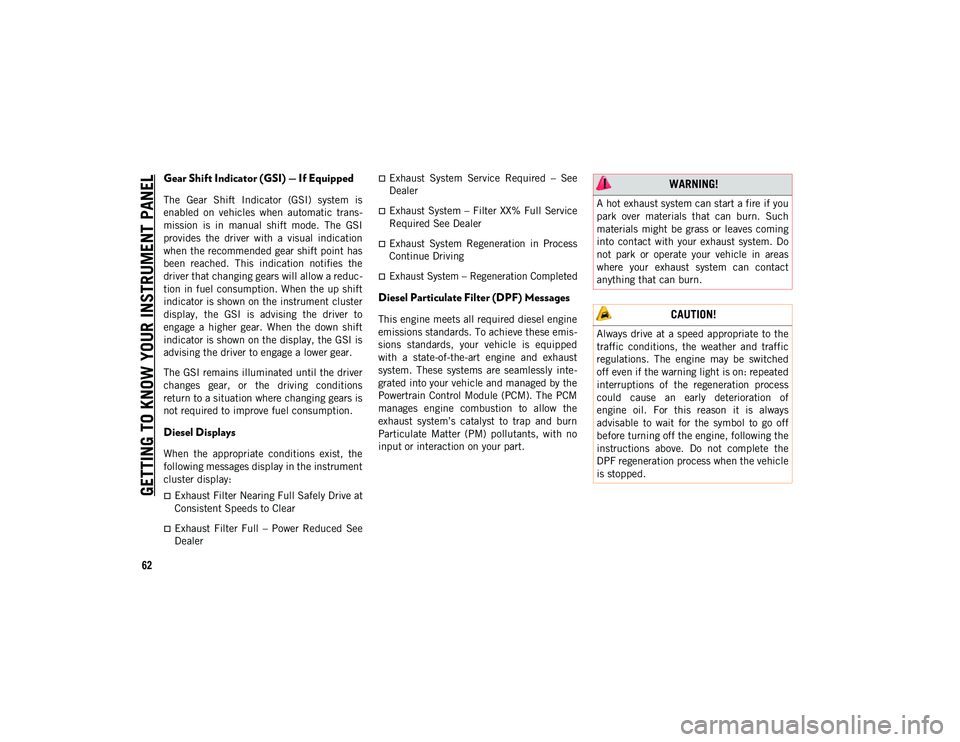
GETTING TO KNOW YOUR INSTRUMENT PANEL
62
Gear Shift Indicator (GSI) ŌĆö If Equipped
The Gear Shift Indicator (GSI) system is
enabled on vehicles when automatic trans-
mission is in manual shift mode. The GSI
provides the driver with a visual indication
when the recommended gear shift point has
been reached. This indication notifies the
driver that changing gears will allow a reduc -
tion in fuel consumption. When the up shift
indicator is shown on the instrument cluster
display, the GSI is advising the driver to
engage a higher gear. When the down shift
indicator is shown on the display, the GSI is
advising the driver to engage a lower gear.
The GSI remains illuminated until the driver
changes gear, or the driving conditions
return to a situation where changing gears is
not required to improve fuel consumption.
Diesel Displays
When the appropriate conditions exist, the
following messages display in the instrument
cluster display:
’ü»Exhaust Filter Nearing Full Safely Drive at
Consistent Speeds to Clear
’ü»Exhaust Filter Full ŌĆō Power Reduced See
Dealer
’ü»Exhaust System Service Required ŌĆō See
Dealer
’ü»Exhaust System ŌĆō Filter XX% Full Service
Required See Dealer
’ü»Exhaust System Regeneration in Process
Continue Driving
’ü»Exhaust System ŌĆō Regeneration Completed
Diesel Particulate Filter (DPF) Messages
This engine meets all required diesel engine
emissions standards. To achieve these emis -
sions standards, your vehicle is equipped
with a state-of-the-art engine and exhaust
system. These systems are seamlessly inte -
grated into your vehicle and managed by the
Powertrain Control Module (PCM). The PCM
manages engine combustion to allow the
exhaust systemŌĆÖs catalyst to trap and burn
Particulate Matter (PM) pollutants, with no
input or interaction on your part.
WARNING!
A hot exhaust system can start a fire if you
park over materials that can burn. Such
materials might be grass or leaves coming
into contact with your exhaust system. Do
not park or operate your vehicle in areas
where your exhaust system can contact
anything that can burn.
CAUTION!
Always drive at a speed appropriate to the
traffic conditions, the weather and traffic
regulations. The engine may be switched
off even if the warning light is on: repeated
interruptions of the regeneration process
could cause an early deterioration of
engine oil. For this reason it is always
advisable to wait for the symbol to go off
before turning off the engine, following the
instructions above. Do not complete the
DPF regeneration process when the vehicle
is stopped.
2020_JEEP_JL_WRANGLER_UG_RHD_UK.book Page 62
Page 74 of 330
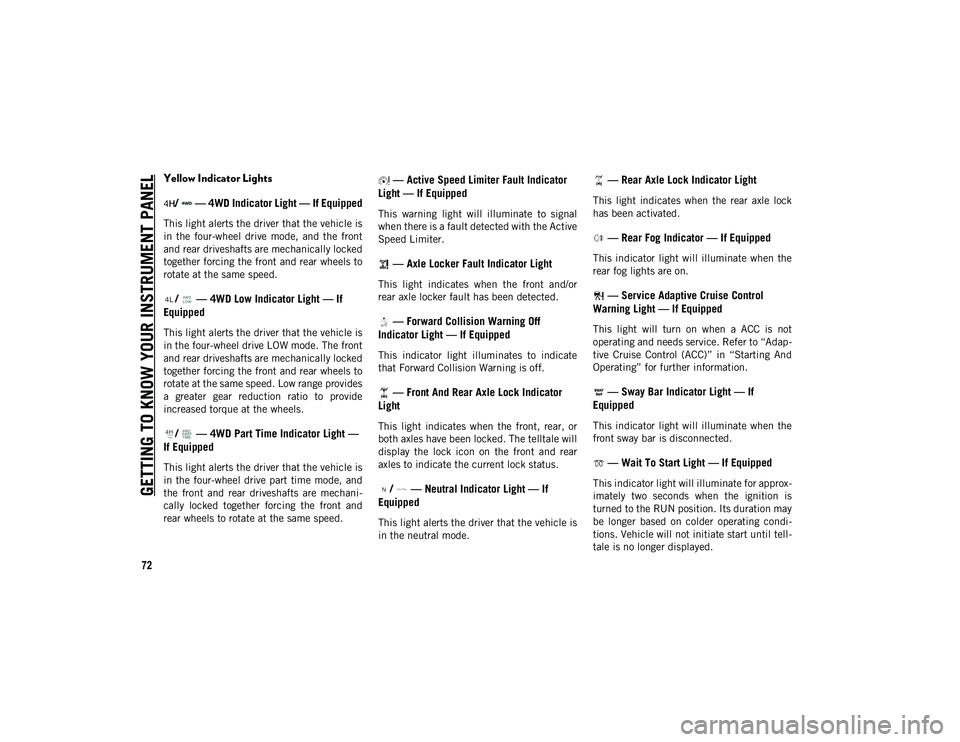
GETTING TO KNOW YOUR INSTRUMENT PANEL
72
Yellow Indicator Lights/ ŌĆö 4WD Indicator Light ŌĆö If Equipped
This light alerts the driver that the vehicle is
in the four-wheel drive mode, and the front
and rear driveshafts are mechanically locked
together forcing the front and rear wheels to
rotate at the same speed.
/ ŌĆö 4WD Low Indicator Light ŌĆö If
Equipped
This light alerts the driver that the vehicle is
in the four-wheel drive LOW mode. The front
and rear driveshafts are mechanically locked
together forcing the front and rear wheels to
rotate at the same speed. Low range provides
a greater gear reduction ratio to provide
increased torque at the wheels.
/ ŌĆö 4WD Part Time Indicator Light ŌĆö
If Equipped
This light alerts the driver that the vehicle is
in the four-wheel drive part time mode, and
the front and rear driveshafts are mechani -
cally locked together forcing the front and
rear wheels to rotate at the same speed.
ŌĆö Active Speed Limiter Fault Indicator
Light ŌĆö If Equipped
This warning light will illuminate to signal
when there is a fault detected with the Active
Speed Limiter.
ŌĆö Axle Locker Fault Indicator Light
This light indicates when the front and/or
rear axle locker fault has been detected.
ŌĆö Forward Collision Warning Off
Indicator Light ŌĆö If Equipped
This indicator light illuminates to indicate
that Forward Collision Warning is off.
ŌĆö Front And Rear Axle Lock Indicator
Light
This light indicates when the front, rear, or
both axles have been locked. The telltale will
display the lock icon on the front and rear
axles to indicate the current lock status.
/ ŌĆö Neutral Indicator Light ŌĆö If
Equipped
This light alerts the driver that the vehicle is
in the neutral mode.
ŌĆö Rear Axle Lock Indicator Light
This light indicates when the rear axle lock
has been activated.
ŌĆö Rear Fog Indicator ŌĆö If Equipped
This indicator light will illuminate when the
rear fog lights are on.
ŌĆö Service Adaptive Cruise Control
Warning Light ŌĆö If Equipped
This light will turn on when a ACC is not
operating and needs service. Refer to ŌĆ£Adap -
tive Cruise Control (ACC)ŌĆØ in ŌĆ£Starting And
OperatingŌĆØ for further information.
ŌĆö Sway Bar Indicator Light ŌĆö If
Equipped
This indicator light will illuminate when the
front sway bar is disconnected.
ŌĆö Wait To Start Light ŌĆö If Equipped
This indicator light will illuminate for approx -
imately two seconds when the ignition is
turned to the RUN position. Its duration may
be longer based on colder operating condi -
tions. Vehicle will not initiate start until tell -
tale is no longer displayed.
2020_JEEP_JL_WRANGLER_UG_RHD_UK.book Page 72
Page 76 of 330
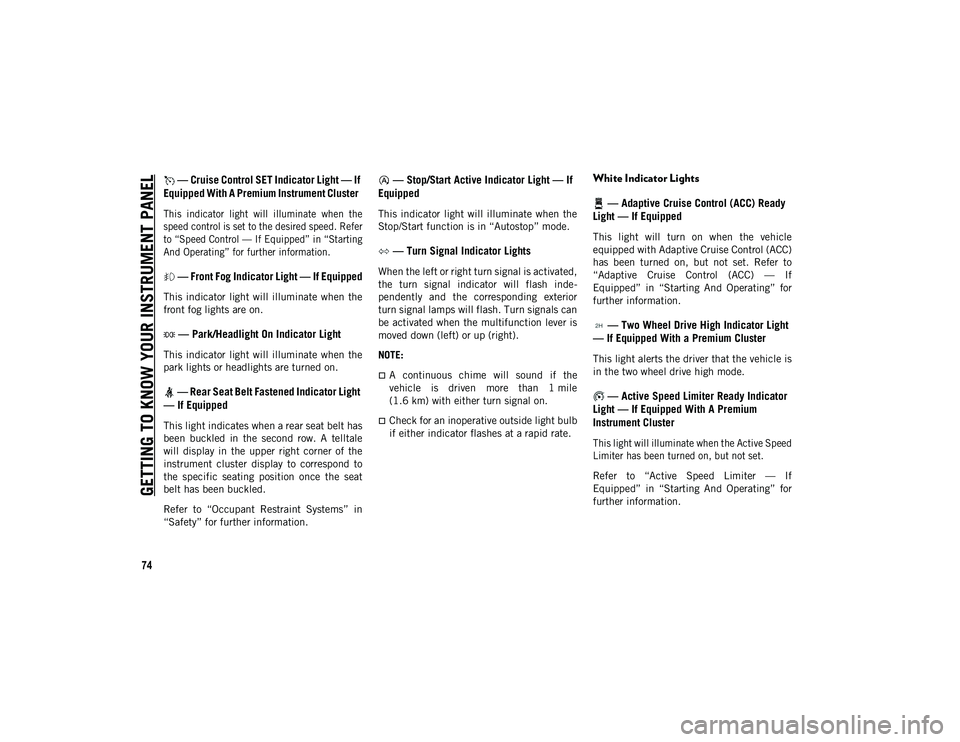
GETTING TO KNOW YOUR INSTRUMENT PANEL
74
ŌĆö Cruise Control SET Indicator Light ŌĆö If
Equipped With A Premium Instrument Cluster
This indicator light will illuminate when the
speed control is set to the desired speed. Refer
to ŌĆ£Speed Control ŌĆö If EquippedŌĆØ in ŌĆ£Starting
And OperatingŌĆØ for further information.
ŌĆö Front Fog Indicator Light ŌĆö If Equipped
This indicator light will illuminate when the
front fog lights are on.
ŌĆö Park/Headlight On Indicator Light
This indicator light will illuminate when the
park lights or headlights are turned on.
ŌĆö Rear Seat Belt Fastened Indicator Light
ŌĆö If Equipped
This light indicates when a rear seat belt has
been buckled in the second row. A telltale
will display in the upper right corner of the
instrument cluster display to correspond to
the specific seating position once the seat
belt has been buckled.
Refer to ŌĆ£Occupant Restraint SystemsŌĆØ in
ŌĆ£SafetyŌĆØ for further information.
ŌĆö Stop/Start Active Indicator Light ŌĆö If
Equipped
This indicator light will illuminate when the
Stop/Start function is in ŌĆ£AutostopŌĆØ mode.
ŌĆö Turn Signal Indicator Lights
When the left or right turn signal is activated,
the turn signal indicator will flash inde -
pendently and the corresponding exterior
turn signal lamps will flash. Turn signals can
be activated when the multifunction lever is
moved down (left) or up (right).
NOTE:
’ü»A continuous chime will sound if the
vehicle is driven more than 1 mile
(1.6 km) with either turn signal on.
’ü»Check for an inoperative outside light bulb
if either indicator flashes at a rapid rate.
White Indicator Lights
ŌĆö Adaptive Cruise Control (ACC) Ready
Light ŌĆö If Equipped
This light will turn on when the vehicle
equipped with Adaptive Cruise Control (ACC)
has been turned on, but not set. Refer to
ŌĆ£Adaptive Cruise Control (ACC) ŌĆö If
EquippedŌĆØ in ŌĆ£Starting And OperatingŌĆØ for
further information.
ŌĆö Two Wheel Drive High Indicator Light
ŌĆö If Equipped With a Premium Cluster
This light alerts the driver that the vehicle is
in the two wheel drive high mode.
ŌĆö Active Speed Limiter Ready Indicator
Light ŌĆö If Equipped With A Premium
Instrument Cluster
This light will illuminate when the Active Speed
Limiter has been turned on, but not set.
Refer to ŌĆ£Active Speed Limiter ŌĆö If
EquippedŌĆØ in ŌĆ£Starting And OperatingŌĆØ for
further information.
2020_JEEP_JL_WRANGLER_UG_RHD_UK.book Page 74
Page 80 of 330
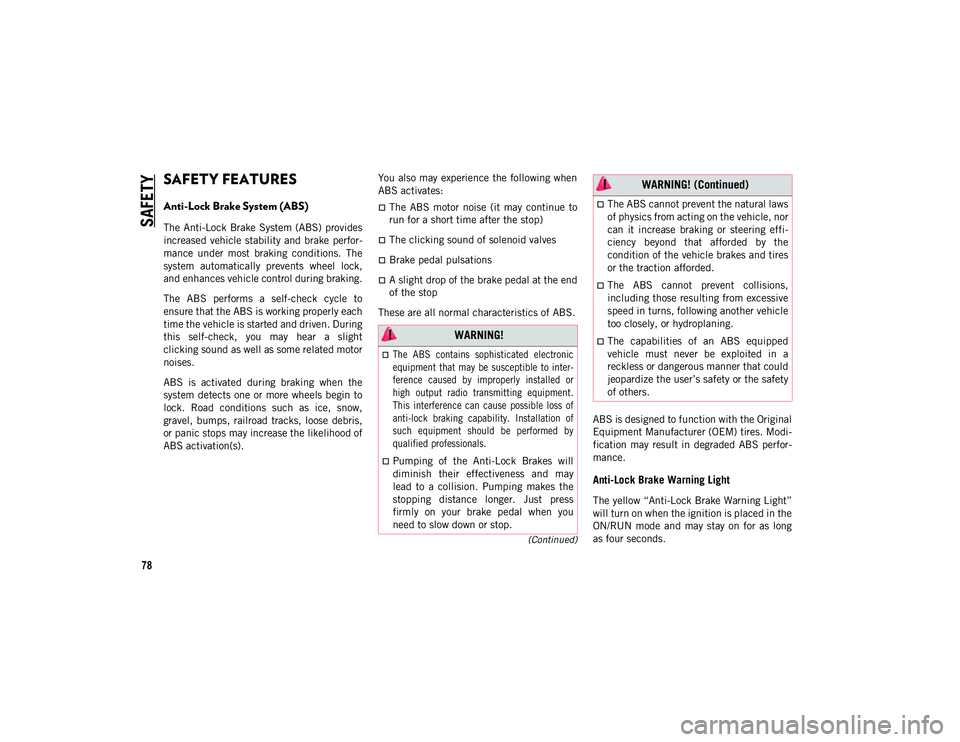
78
(Continued)
SAFETY
SAFETY FEATURES
Anti-Lock Brake System (ABS)
The Anti-Lock Brake System (ABS) provides
increased vehicle stability and brake perfor-
mance under most braking conditions. The
system automatically prevents wheel lock,
and enhances vehicle control during braking.
The ABS performs a self-check cycle to
ensure that the ABS is working properly each
time the vehicle is started and driven. During
this self-check, you may hear a slight
clicking sound as well as some related motor
noises.
ABS is activated during braking when the
system detects one or more wheels begin to
lock. Road conditions such as ice, snow,
gravel, bumps, railroad tracks, loose debris,
or panic stops may increase the likelihood of
ABS activation(s). You also may experience the following when
ABS activates:
’ü»The ABS motor noise (it may continue to
run for a short time after the stop)
’ü»The clicking sound of solenoid valves
’ü»Brake pedal pulsations
’ü»A slight drop of the brake pedal at the end
of the stop
These are all normal characteristics of ABS.
ABS is designed to function with the Original
Equipment Manufacturer (OEM) tires. Modi-
fication may result in degraded ABS perfor -
mance.
Anti-Lock Brake Warning Light
The yellow ŌĆ£Anti-Lock Brake Warning LightŌĆØ
will turn on when the ignition is placed in the
ON/RUN mode and may stay on for as long
as four seconds.
WARNING!
’ü»The ABS contains sophisticated electronic
equipment that may be susceptible to inter -
ference caused by improperly installed or
high output radio transmitting equipment.
This interference can cause possible loss of
anti-lock braking capability. Installation of
such equipment should be performed by
qualified professionals.
’ü»Pumping of the Anti-Lock Brakes will
diminish their effectiveness and may
lead to a collision. Pumping makes the
stopping distance longer. Just press
firmly on your brake pedal when you
need to slow down or stop.
’ü»The ABS cannot prevent the natural laws
of physics from acting on the vehicle, nor
can it increase braking or steering effi -
ciency beyond that afforded by the
condition of the vehicle brakes and tires
or the traction afforded.
’ü»The ABS cannot prevent collisions,
including those resulting from excessive
speed in turns, following another vehicle
too closely, or hydroplaning.
’ü»The capabilities of an ABS equipped
vehicle must never be exploited in a
reckless or dangerous manner that could
jeopardize the userŌĆÖs safety or the safety
of others.
WARNING! (Continued)
2020_JEEP_JL_WRANGLER_UG_RHD_UK.book Page 78
Page 81 of 330
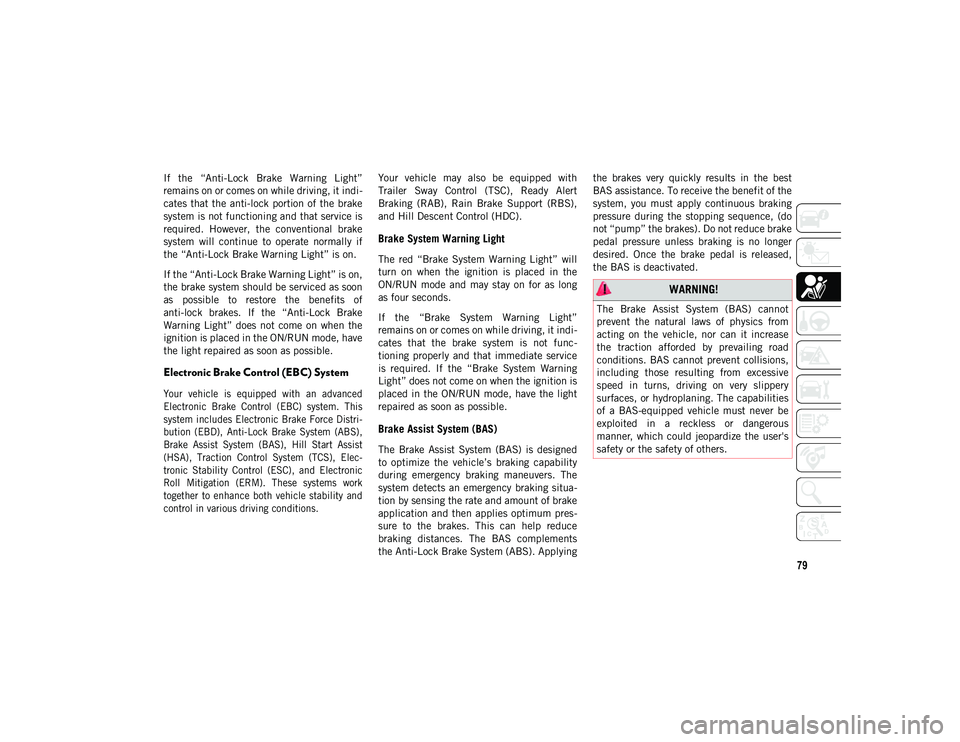
79
If the ŌĆ£Anti-Lock Brake Warning LightŌĆØ
remains on or comes on while driving, it indi-
cates that the anti-lock portion of the brake
system is not functioning and that service is
required. However, the conventional brake
system will continue to operate normally if
the ŌĆ£Anti-Lock Brake Warning LightŌĆØ is on.
If the ŌĆ£Anti-Lock Brake Warning LightŌĆØ is on,
the brake system should be serviced as soon
as possible to restore the benefits of
anti-lock brakes. If the ŌĆ£Anti-Lock Brake
Warning LightŌĆØ does not come on when the
ignition is placed in the ON/RUN mode, have
the light repaired as soon as possible.
Electronic Brake Control (EBC) System
Your vehicle is equipped with an advanced
Electronic Brake Control (EBC) system. This
system includes Electronic Brake Force Distri -
bution (EBD), Anti-Lock Brake System (ABS),
Brake Assist System (BAS), Hill Start Assist
(HSA), Traction Control System (TCS), Elec-
tronic Stability Control (ESC), and Electronic
Roll Mitigation (ERM). These systems work
together to enhance both vehicle stability and
control in various driving conditions.
Your vehicle may also be equipped with
Trailer Sway Control (TSC), Ready Alert
Braking (RAB), Rain Brake Support (RBS),
and Hill Descent Control (HDC).
Brake System Warning Light
The red ŌĆ£Brake System Warning LightŌĆØ will
turn on when the ignition is placed in the
ON/RUN mode and may stay on for as long
as four seconds.
If the ŌĆ£Brake System Warning LightŌĆØ
remains on or comes on while driving, it indi
-
cates that the brake system is not func -
tioning properly and that immediate service
is required. If the ŌĆ£Brake System Warning
LightŌĆØ does not come on when the ignition is
placed in the ON/RUN mode, have the light
repaired as soon as possible.
Brake Assist System (BAS)
The Brake Assist System (BAS) is designed
to optimize the vehicleŌĆÖs braking capability
during emergency braking maneuvers. The
system detects an emergency braking situa -
tion by sensing the rate and amount of brake
application and then applies optimum pres -
sure to the brakes. This can help reduce
braking distances. The BAS complements
the Anti-Lock Brake System (ABS). Applying the brakes very quickly results in the best
BAS assistance. To receive the benefit of the
system, you must apply continuous braking
pressure during the stopping sequence, (do
not ŌĆ£pumpŌĆØ the brakes). Do not reduce brake
pedal pressure unless braking is no longer
desired. Once the brake pedal is released,
the BAS is deactivated.
WARNING!
The Brake Assist System (BAS) cannot
prevent the natural laws of physics from
acting on the vehicle, nor can it increase
the traction afforded by prevailing road
conditions. BAS cannot prevent collisions,
including those resulting from excessive
speed in turns, driving on very slippery
surfaces, or hydroplaning. The capabilities
of a BAS-equipped vehicle must never be
exploited in a reckless or dangerous
manner, which could jeopardize the user's
safety or the safety of others.
2020_JEEP_JL_WRANGLER_UG_RHD_UK.book Page 79
Page 82 of 330
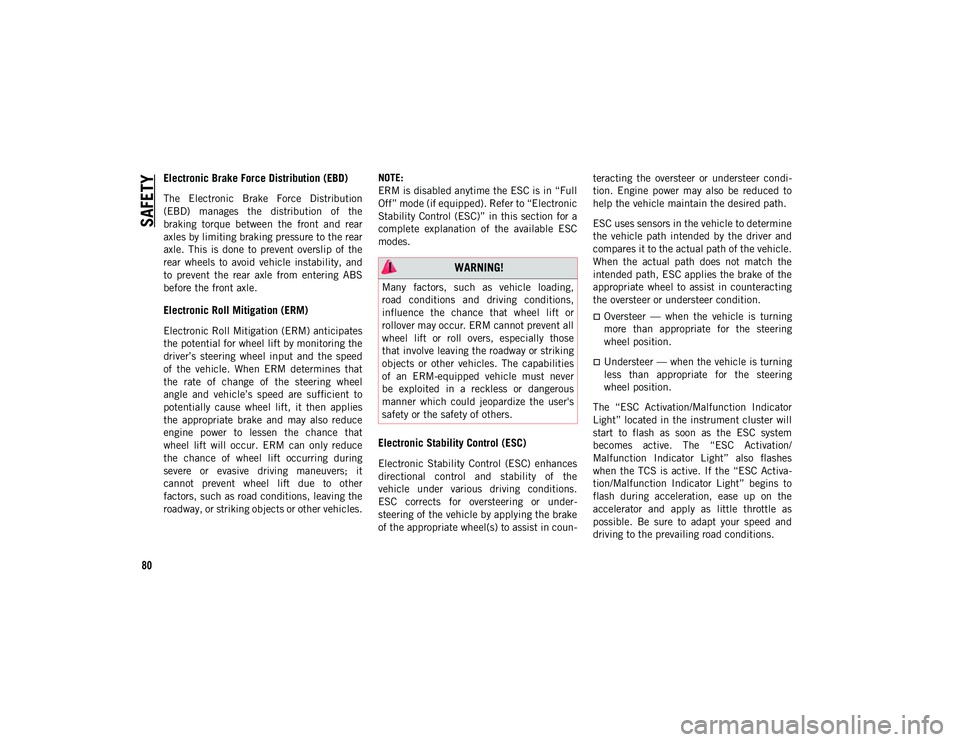
SAFETY
80
Electronic Brake Force Distribution (EBD)
The Electronic Brake Force Distribution
(EBD) manages the distribution of the
braking torque between the front and rear
axles by limiting braking pressure to the rear
axle. This is done to prevent overslip of the
rear wheels to avoid vehicle instability, and
to prevent the rear axle from entering ABS
before the front axle.
Electronic Roll Mitigation (ERM)
Electronic Roll Mitigation (ERM) anticipates
the potential for wheel lift by monitoring the
driverŌĆÖs steering wheel input and the speed
of the vehicle. When ERM determines that
the rate of change of the steering wheel
angle and vehicleŌĆÖs speed are sufficient to
potentially cause wheel lift, it then applies
the appropriate brake and may also reduce
engine power to lessen the chance that
wheel lift will occur. ERM can only reduce
the chance of wheel lift occurring during
severe or evasive driving maneuvers; it
cannot prevent wheel lift due to other
factors, such as road conditions, leaving the
roadway, or striking objects or other vehicles.NOTE:
ERM is disabled anytime the ESC is in ŌĆ£Full
OffŌĆØ mode (if equipped). Refer to ŌĆ£Electronic
Stability Control (ESC)ŌĆØ in this section for a
complete explanation of the available ESC
modes.
Electronic Stability Control (ESC)
Electronic Stability Control (ESC) enhances
directional control and stability of the
vehicle under various driving conditions.
ESC corrects for oversteering or under
-
steering of the vehicle by applying the brake
of the appropriate wheel(s) to assist in coun -teracting the oversteer or understeer condi
-
tion. Engine power may also be reduced to
help the vehicle maintain the desired path.
ESC uses sensors in the vehicle to determine
the vehicle path intended by the driver and
compares it to the actual path of the vehicle.
When the actual path does not match the
intended path, ESC applies the brake of the
appropriate wheel to assist in counteracting
the oversteer or understeer condition.
’ü»Oversteer ŌĆö when the vehicle is turning
more than appropriate for the steering
wheel position.
’ü»Understeer ŌĆö when the vehicle is turning
less than appropriate for the steering
wheel position.
The ŌĆ£ESC Activation/Malfunction Indicator
LightŌĆØ located in the instrument cluster will
start to flash as soon as the ESC system
becomes active. The ŌĆ£ESC Activation/
Malfunction Indicator LightŌĆØ also flashes
when the TCS is active. If the ŌĆ£ESC Activa -
tion/Malfunction Indicator LightŌĆØ begins to
flash during acceleration, ease up on the
accelerator and apply as little throttle as
possible. Be sure to adapt your speed and
driving to the prevailing road conditions.
WARNING!
Many factors, such as vehicle loading,
road conditions and driving conditions,
influence the chance that wheel lift or
rollover may occur. ERM cannot prevent all
wheel lift or roll overs, especially those
that involve leaving the roadway or striking
objects or other vehicles. The capabilities
of an ERM-equipped vehicle must never
be exploited in a reckless or dangerous
manner which could jeopardize the user's
safety or the safety of others.
2020_JEEP_JL_WRANGLER_UG_RHD_UK.book Page 80